Atmospheric Factors Affecting Global Solar and Photosynthetically Active Radiation Relationship in a Mediterranean Forest Site
Abstract
:1. Introduction
2. Materials and Methods
- Measurements recorded at solar elevation angles less than 12°, due to cosine response inconsistencies of the sensors, as suggested by Ge et al. [6].
- Energy fluxes of PAR (in W m−2) greater than Rs.
- Rs flux densities greater than Ra.
- Rs values less than 5 W m−2.
- Measurements recorded at air temperatures below zero.
3. Results and Discussion
3.1. Temporal Variation
3.2. Solar Attributes Effects
3.3. Temperature Effects
3.4. Air Water Content Effects
4. Conclusions
Author Contributions
Funding
Institutional Review Board Statement
Data Availability Statement
Acknowledgments
Conflicts of Interest
References
- Liakatas, A.; Proutsos, N.; Alexandris, S. Optical properties affecting the radiant energy of an oak forest. Meteorol. Appl. 2002, 9, 433–436. [Google Scholar] [CrossRef]
- Proutsos, N.; Alexandris, S.; Liakatas, A.; Nastos, P.; Tsiros, I.X. PAR and UVA composition of global solar radiation at a high altitude Mediterranean forest site. Atmos. Res. 2022, 269, 106039. [Google Scholar] [CrossRef]
- Proutsos, N.; Liakatas, A.; Alexandris, S. Ratio of photosynthetically active to total incoming radiation above a Mediterranean deciduous oak forest. Theor. Appl. Climatol. 2019, 137, 2927–2939. [Google Scholar] [CrossRef]
- Proutsos, N.; Liakatas, A.; Alexandris, S.; Tsiros, I. Carbon fluxes above a deciduous forest in Greece. Atmósfera 2017, 30, 311–322. [Google Scholar] [CrossRef] [Green Version]
- Ferrera-Cobos, F.; Vindel, J.M.; Valenzuela, R.X.; González, J.A. Analysis of spatial and temporal variability of the PAR/GHI ratio and PAR modeling based on two satellite estimates. Remote Sens. 2020, 12, 1262. [Google Scholar] [CrossRef] [Green Version]
- Ge, S.; Smith, R.G.; Jacovides, C.P.; Kramer, M.G.; Carruthers, R.I. Dynamics of photosynthetic photon flux density (PPFD) and estimates in coastal northern California. Theor. Appl. Climatol. 2011, 105, 107–118. [Google Scholar] [CrossRef] [Green Version]
- Niu, Z.; Wang, L.; Niu, Y.; Hu, B.; Zhang, M.; Qin, W. Spatiotemporal variations of photosynthetically active radiation and the influencing factors in China from 1961 to 2016. Theor. Appl. Climatol. 2019, 137, 2049–2067. [Google Scholar] [CrossRef]
- Wang, L.; Kisi, O.; Zounemat-Kermani, M.; Hu, B.; Gong, W. Modeling and comparison of hourly photosynthetically active radiation in different ecosystems. Renew. Sustain. Energy Rev. 2016, 56, 436–453. [Google Scholar] [CrossRef]
- Aguiar, L.J.; Fischer, G.R.; Ladle, R.J.; Malhado, A.; Justino, F.B.; Aguiar, R.G.; da Costa, J.M.N. Modeling the photosynthetically active radiation in South West Amazonia under all sky conditions. Theor. Appl. Climatol. 2012, 108, 631–640. [Google Scholar] [CrossRef]
- Alados, I.; Foyo-Moreno, I.; Alados-Arboledas, L. Photosynthetically active radiation: Measurements and modelling. Agric. For. Meteorol. 1996, 78, 121–131. [Google Scholar] [CrossRef]
- Foyo-Moreno, I.; Alados, I.; Alados-Arboledas, L. A new conventional regression model to estimate hourly photosynthetic photon flux density under all sky conditions. Int. J. Climatol. 2017, 37, 1067–1075. [Google Scholar] [CrossRef] [Green Version]
- Gonzalez, J.; Calbó, J. Modelled and measured ratio of PAR to global radiation under cloudless skies. Agric. For. Meteorol. 2002, 110, 319–325. [Google Scholar] [CrossRef]
- Mizoguchi, Y.; Yasuda, Y.; Ohtani, Y.; Watanabe, T.; Kominami, Y.; Yamanoi, K. A practical model to estimate photosynthetically active radiation using general meteorological elements in a temperate humid area and comparison among models. Theor. Appl. Climatol. 2014, 115, 583–589. [Google Scholar] [CrossRef]
- Noriega Gardea, M.M.Á.; Corral Martínez, L.F.; Anguiano Morales, M.; Trujillo Schiaffino, G.; Salas Peimbert, D.P. Modeling photosynthetically active radiation: A review. Atmósfera 2021, 34, 357–370. [Google Scholar] [CrossRef]
- Custódio, L.L.; Silva, B.B.D.; dos Santos, C.A. Relationship between photosynthetically active radiation and global radiation in Petrolina and Brasília, Brazil. Rev. Bras. Eng. Agríc. Ambient. 2021, 25, 612–619. [Google Scholar] [CrossRef]
- Peng, S.; Du, Q.; Lin, A.; Hu, B.; Xiao, K.; Xi, Y. Observation and estimation of photosynthetically active radiation in Lhasa (Tibetan Plateau). Adv. Space Res. 2015, 55, 1604–1612. [Google Scholar] [CrossRef]
- Akitsu, T.K.; Nasahara, K.N.; Ijima, O.; Hirose, Y.; Ide, R.; Takagi, K.; Kume, A. The variability and seasonality in the ratio of photosynthetically active radiation to solar radiation: A simple empirical model of the ratio. Int. J. Appl. Earth Obs. Geoinf. 2022, 108, 102724. [Google Scholar] [CrossRef]
- Wang, L.; Gong, W.; Li, C.; Lin, A.; Hu, B.; Ma, Y. Measurement and estimation of photosynthetically active radiation from 1961 to 2011 in Central China. Appl. Energy 2013, 111, 1010–1017. [Google Scholar] [CrossRef]
- Wang, L.; Gong, W.; Lin, A.; Hu, B. Analysis of photosynthetically active radiation under various sky conditions in Wuhan, Central China. Int. J. Biometeorol. 2014, 58, 1711–1720. [Google Scholar] [CrossRef]
- Wang, L.; Gong, W.; Ma, Y.; Hu, B.; Zhang, M. Photosynthetically active radiation and its relationship with global solar radiation in Central China. Int. J. Biometeorol. 2014, 58, 1265–1277. [Google Scholar] [CrossRef] [PubMed]
- Yu, X.; Wu, Z.; Jiang, W.; Guo, X. Predicting daily photosynthetically active radiation from global solar radiation in the Contiguous United States. Energy Convers. Manag. 2015, 89, 71–82. [Google Scholar] [CrossRef]
- Lozano, I.; Sánchez-Hernández, G.; Guerrero-Rascado, J.; Alados, I.; Foyo-Moreno, I. Analysis of cloud effects on long-term global and diffuse photosynthetically active radiation at a Mediterranean site. Atmos. Res. 2022, 268, 106010. [Google Scholar] [CrossRef]
- Zempila, M.-M.; Taylor, M.; Bais, A.; Kazadzis, S. Modeling the relationship between photosynthetically active radiation and global horizontal irradiance using singular spectrum analysis. J. Quant. Spectrosc. Radiat. Transf. 2016, 182, 240–263. [Google Scholar] [CrossRef]
- Meek, D.; Hatfield, J.; Howell, T.; Idso, S.; Reginato, R. A generalized relationship between photosynthetically active radiation and solar radiation 1. Agron. J. 1984, 76, 939–945. [Google Scholar] [CrossRef]
- Udo, S.; Aro, T. Global PAR related to global solar radiation for central Nigeria. Agric. For. Meteorol. 1999, 97, 21–31. [Google Scholar] [CrossRef]
- Akitsu, T.; Kume, A.; Hirose, Y.; Ijima, O.; Nasahara, K.N. On the stability of radiometric ratios of photosynthetically active radiation to global solar radiation in Tsukuba, Japan. Agric. For. Meteorol. 2015, 209, 59–68. [Google Scholar] [CrossRef]
- Jacovides, C.; Tymvios, F.; Asimakopoulos, D.; Theofilou, K.; Pashiardes, S. Global photosynthetically active radiation and its relationship with global solar radiation in the Eastern Mediterranean basin. Theor. Appl. Climatol. 2003, 74, 227–233. [Google Scholar] [CrossRef]
- Li, R.; Zhao, L.; Ding, Y.; Wang, S.; Ji, G.; Xiao, Y.; Liu, G.; Sun, L. Monthly ratios of PAR to global solar radiation measured at northern Tibetan Plateau, China. Sol. Energy 2010, 84, 964–973. [Google Scholar] [CrossRef]
- NATURA2000-SDF. Natura 2000 Standard Data Form for Special Protection Areas (SPA). Site GR1220009 “Limnes Koroneias-Volvis, Stena Ren-Tinas Kai Evryteri Periochi”. Available online: https://natura2000.eea.europa.eu/Natura2000/SDF.aspx?site=GR1220009 (accessed on 26 May 2022).
- NATURA2000-SDF. Natura 2000 Standard Data Form for Special Protection Areas (SPA). Site GR1270012 “OROS CHOLOMONTAS”. Available online: https://natura2000.eea.europa.eu/Natura2000/SDF.aspx?site=GR1270012 (accessed on 26 May 2022).
- NATURA2000-SDF. Natura 2000 Standard Data Form for Sites of Community Importance (SCI). Site GR1270001 “Oros Cholomontas”. Available online: https://natura2000.eea.europa.eu/Natura2000/SDF.aspx?site=GR1270001 (accessed on 26 May 2022).
- Proutsos, N.D.; Tsiros, I.X.; Nastos, P.; Tsaousidis, A. A note on some uncertainties associated with Thornthwaite’s aridity index introduced by using different potential evapotranspiration methods. Atmos. Res. 2021, 260, 105727. [Google Scholar] [CrossRef]
- Tsiros, I.X.; Nastos, P.; Proutsos, N.D.; Tsaousidis, A. Variability of the aridity index and related drought parameters in Greece using climatological data over the last century (1900–1997). Atmos. Res. 2020, 240, 104914. [Google Scholar] [CrossRef]
- Arnold, E. World Atlas of Desertification; UNEP: London, UK, 1992. [Google Scholar]
- Thornthwaite, C. Una aproximación para una clasificación racional del clima (An approach toward a rational classification of climate). Geogr. Rev. 1948, 38, 85–94. [Google Scholar] [CrossRef]
- Iqbal, M. An Introduction to Solar Radiation; Elsevier: New York, NY, USA, 1983. [Google Scholar]
- Liang, F.; Xia, X. Long-term trends in solar radiation and the associated climatic factors over China for 1961–2000. Ann. Geophys. 2005, 23, 2425–2432. [Google Scholar] [CrossRef] [Green Version]
- Tsubo, M.; Walker, S. Relationships between photosynthetically active radiation and clearness index at Bloemfontein, South Africa. Theor. Appl. Climatol. 2005, 80, 17–25. [Google Scholar] [CrossRef]
- Duffie, J.A.; Beckman, W.A. Solar Engineering of Thermal Processes; Research Supported by the University of Wisconsin; Wiley-Interscience: New York, NY, USA, 1980; p. 775. [Google Scholar]
- Hu, B.; Wang, Y.; Liu, G. Long-term trends in photosynthetically active radiation in Beijing. Adv. Atmos. Sci. 2010, 27, 1380–1388. [Google Scholar] [CrossRef]
- Kaplanis, S.; Kaplani, E. Stochastic prediction of hourly global solar radiation for Patra, Greece. Appl. Energy 2010, 87, 3748–3758. [Google Scholar] [CrossRef]
- Kasten, F.; Young, A.T. Revised optical air mass tables and approximation formula. Appl. Opt. 1989, 28, 4735–4738. [Google Scholar] [CrossRef]
- Tetens, O. Uber einige meteorologische Begriffe. Z. Geophys. 1930, 6, 297–309. [Google Scholar]
- McCree, K.J. Test of current definitions of photosynthetically active radiation against leaf photosynthesis data. Agric. Meteorol. 1972, 10, 443–453. [Google Scholar] [CrossRef]
- Wang, L.; Gong, W.; Feng, L.; Lin, A.; Hu, B.; Zhou, M. Estimation of hourly and daily photosynthetically active radiation in Inner Mongolia, China, from 1990 to 2012. Int. J. Climatol. 2015, 35, 3120–3131. [Google Scholar] [CrossRef]
- Zhu, Z.; Wang, L.; Gong, W.; Xiong, Y.; Hu, B. Observation and estimation of photosynthetic photon flux density in Southern China. Theor. Appl. Climatol. 2015, 120, 701–712. [Google Scholar] [CrossRef]
- Papaioannou, G.; Nikolidakis, G.; Asimakopoulos, D.; Retalis, D. Photosynthetically active radiation in Athens. Agric. For. Meteorol. 1996, 81, 287–298. [Google Scholar] [CrossRef]
- Papaioannou, G.; Papanikolaou, N.; Retalis, D. Relationships of photosynthetically active radiation and shortwave irradiance. Theor. Appl. Climatol. 1993, 48, 23–27. [Google Scholar] [CrossRef]
- Jacovides, C.; Tymvios, F.; Assimakopoulos, V.; Kaltsounides, N. The dependence of global and diffuse PAR radiation components on sky conditions at Athens, Greece. Agric. For. Meteorol. 2007, 143, 277–287. [Google Scholar] [CrossRef]
- Hu, B.; Wang, Y.; Liu, G. Measurements and estimations of photosynthetically active radiation in Beijing. Atmos. Res. 2007, 85, 361–371. [Google Scholar] [CrossRef]
- Finch, D.; Bailey, W.; McArthur, L.; Nasitwitwi, M. Photosynthetically active radiation regimes in a southern African savanna environment. Agric. For. Meteorol. 2004, 122, 229–238. [Google Scholar] [CrossRef]
- Zhang, X.; Zhang, Y.; Zhoub, Y. Measuring and modelling photosynthetically active radiation in Tibet Plateau during April–October. Agric. For. Meteorol. 2000, 102, 207–212. [Google Scholar] [CrossRef]
- Howell, T.; Meek, D.; Hatfield, J. Relationship of photosynthetically active radiation to shortwave radiation in the San Joaquin Valley. Agric. Meteorol. 1983, 28, 157–175. [Google Scholar] [CrossRef]
- Nagaraja Rao, C. Photosynthetically active components of global solar radiation: Measurements and model computations. Arch. Meteorol. Geophys. Bioclimatol. Ser. B 1984, 34, 353–364. [Google Scholar] [CrossRef]
- Jacovides, C.; Timvios, F.; Papaioannou, G.; Asimakopoulos, D.; Theofilou, C. Ratio of PAR to broadband solar radiation measured in Cyprus. Agric. For. Meteorol. 2004, 121, 135–140. [Google Scholar] [CrossRef]
- Stanhill, G.; Fuchs, M. The relative flux density of photosynthetically active radiation. J. Appl. Ecol. 1977, 14, 317–322. [Google Scholar] [CrossRef]
- Escobedo, J.F.; Gomes, E.N.; Oliveira, A.P.; Soares, J. Ratios of UV, PAR and NIR components to global solar radiation measured at Botucatu site in Brazil. Renew. Energy 2011, 36, 169–178. [Google Scholar] [CrossRef]
- Pashiardis, S.; Kalogirou, S.A.; Pelengaris, A. Statistical analysis for the characterization of solar energy utilization and inter-comparison of solar radiation at two sites in Cyprus. Appl. Energy 2017, 190, 1138–1158. [Google Scholar] [CrossRef]
- Mottus, M.; Ross, J.; Sulev, M. Experimental study of ratio of PAR to direct integral solar radiation under cloudless conditions. Agric. For. Meteorol. 2001, 109, 161–170. [Google Scholar] [CrossRef]
- Hu, B.; Liu, H.; Wang, Y. Investigation of the variability of photosynthetically active radiation in the Tibetan Plateau, China. Renew. Sustain. Energy Rev. 2016, 55, 240–248. [Google Scholar] [CrossRef]
- Hu, B.; Tang, L.; Liu, H.; Zhao, X.; Liu, Z.; Wang, Y.; Wang, L. Trends of photosynthetically active radiation over China from 1961 to 2014. Int. J. Climatol. 2018, 38, 4007–4024. [Google Scholar] [CrossRef]

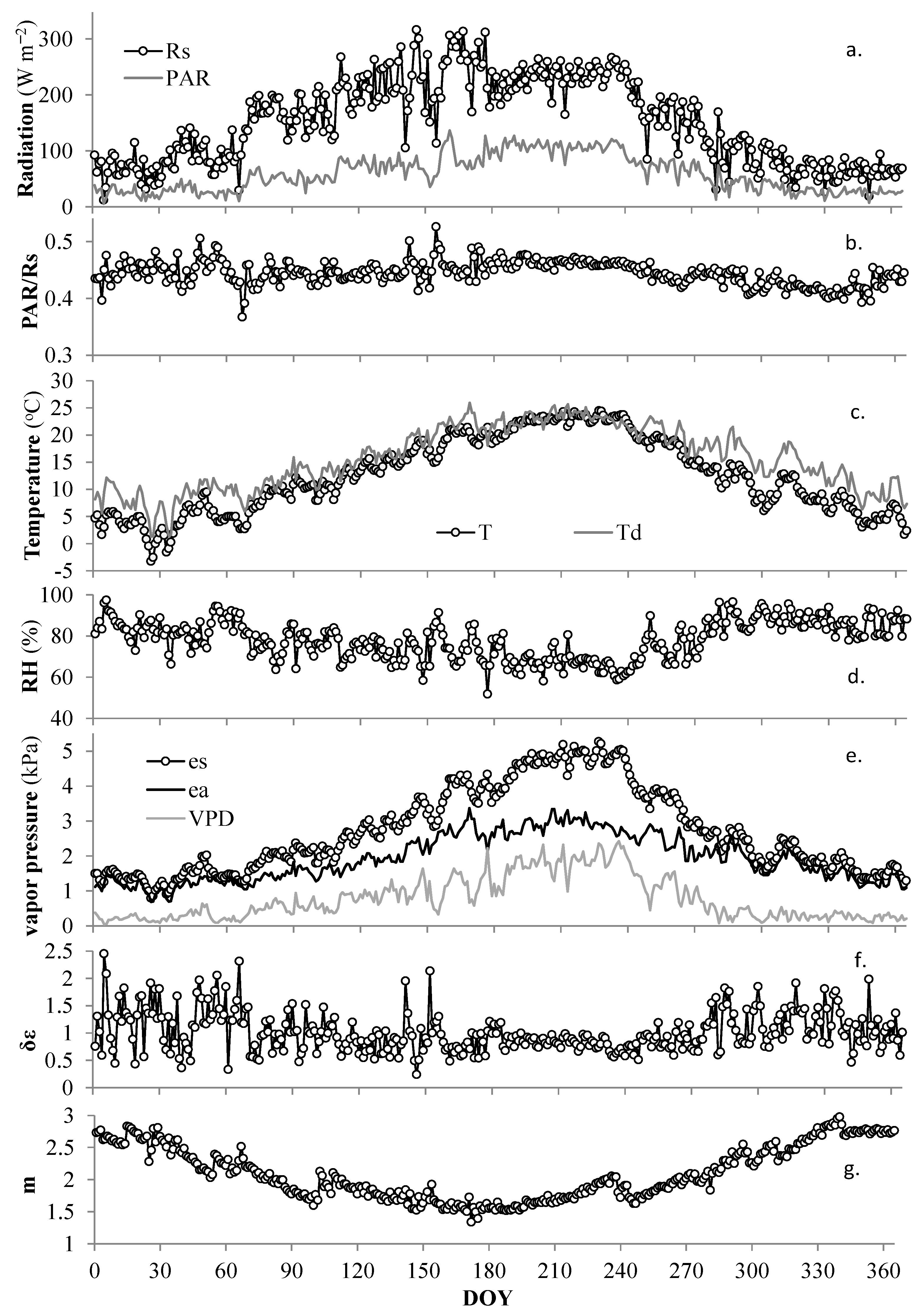
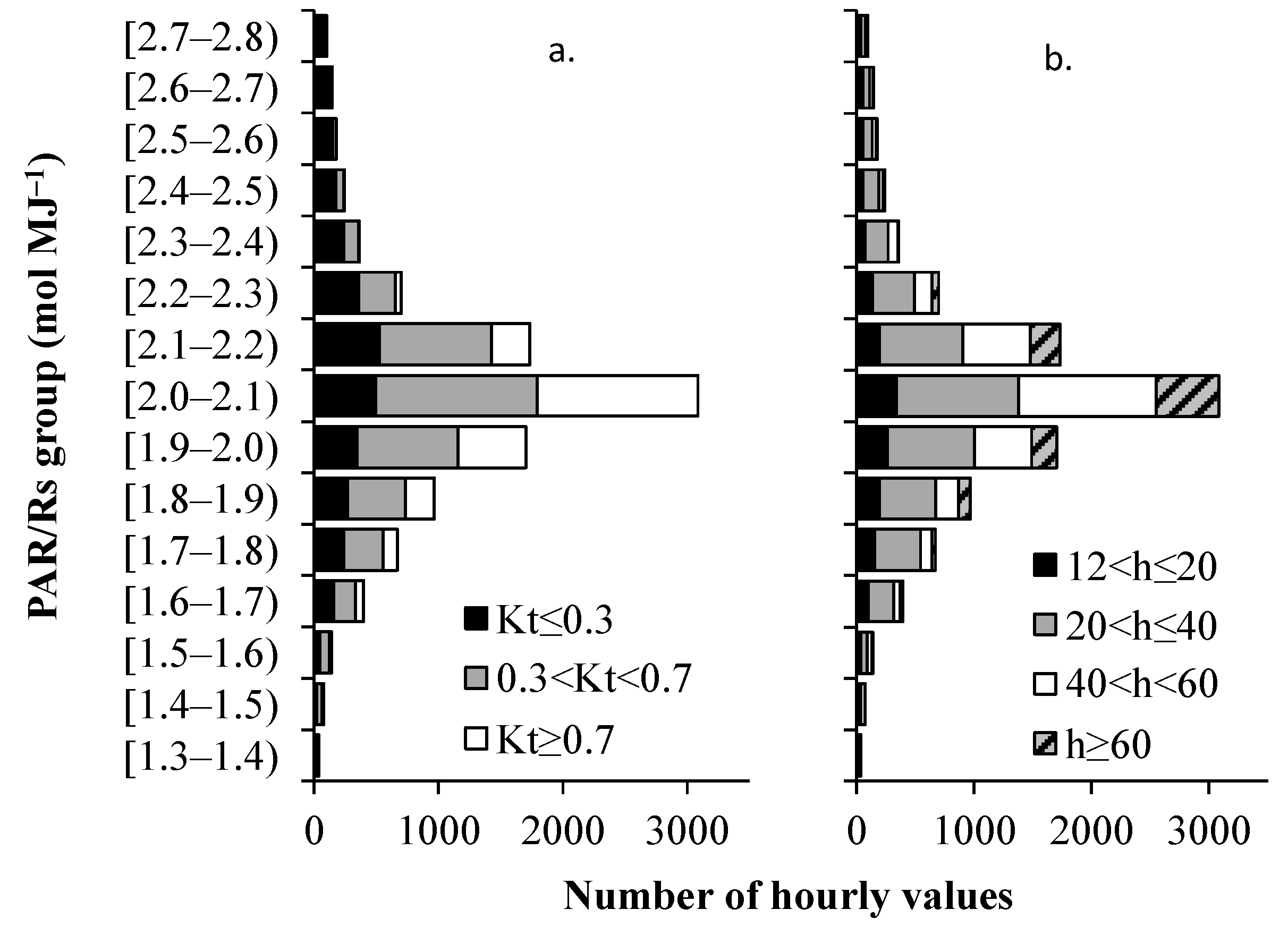

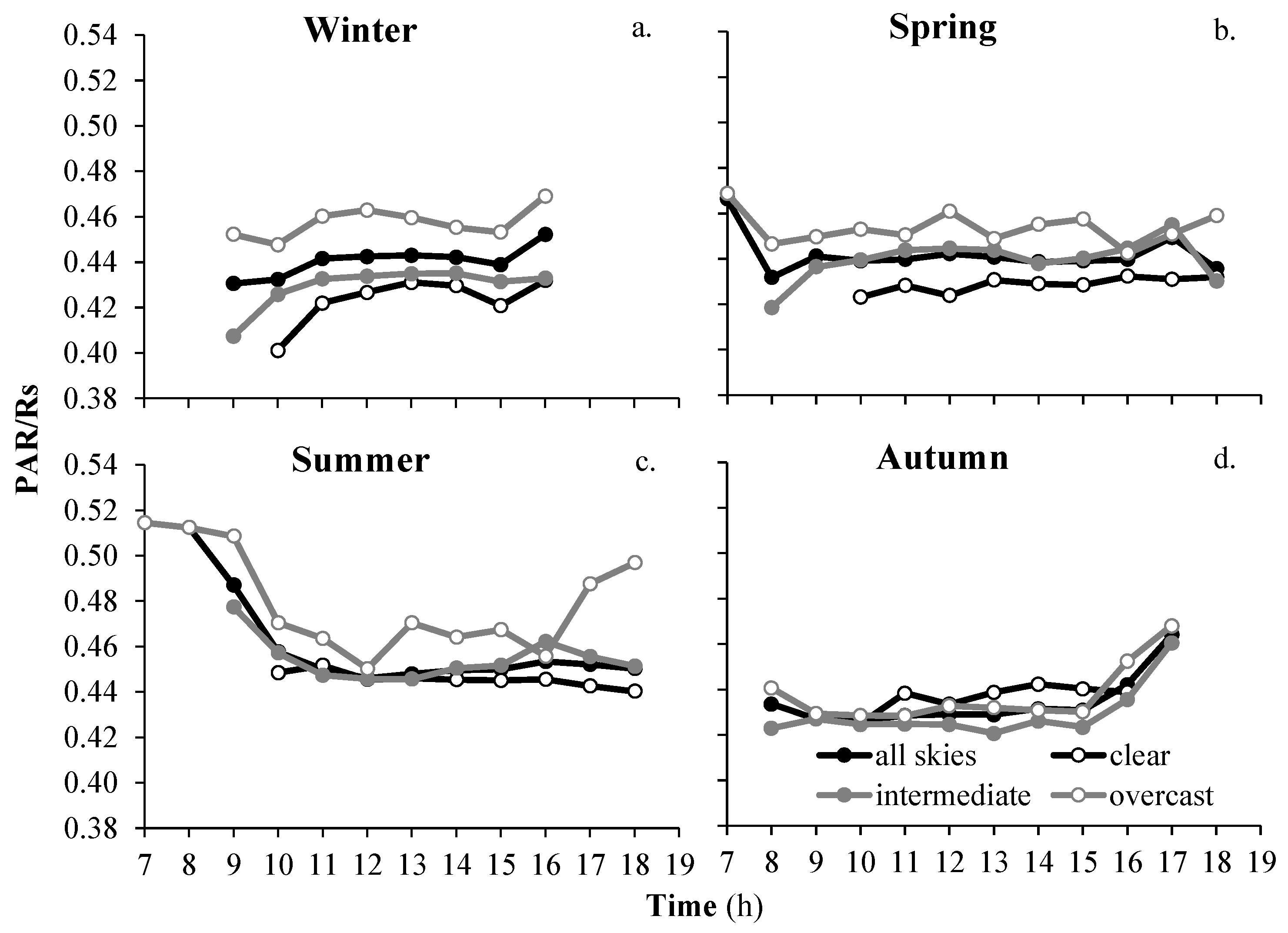
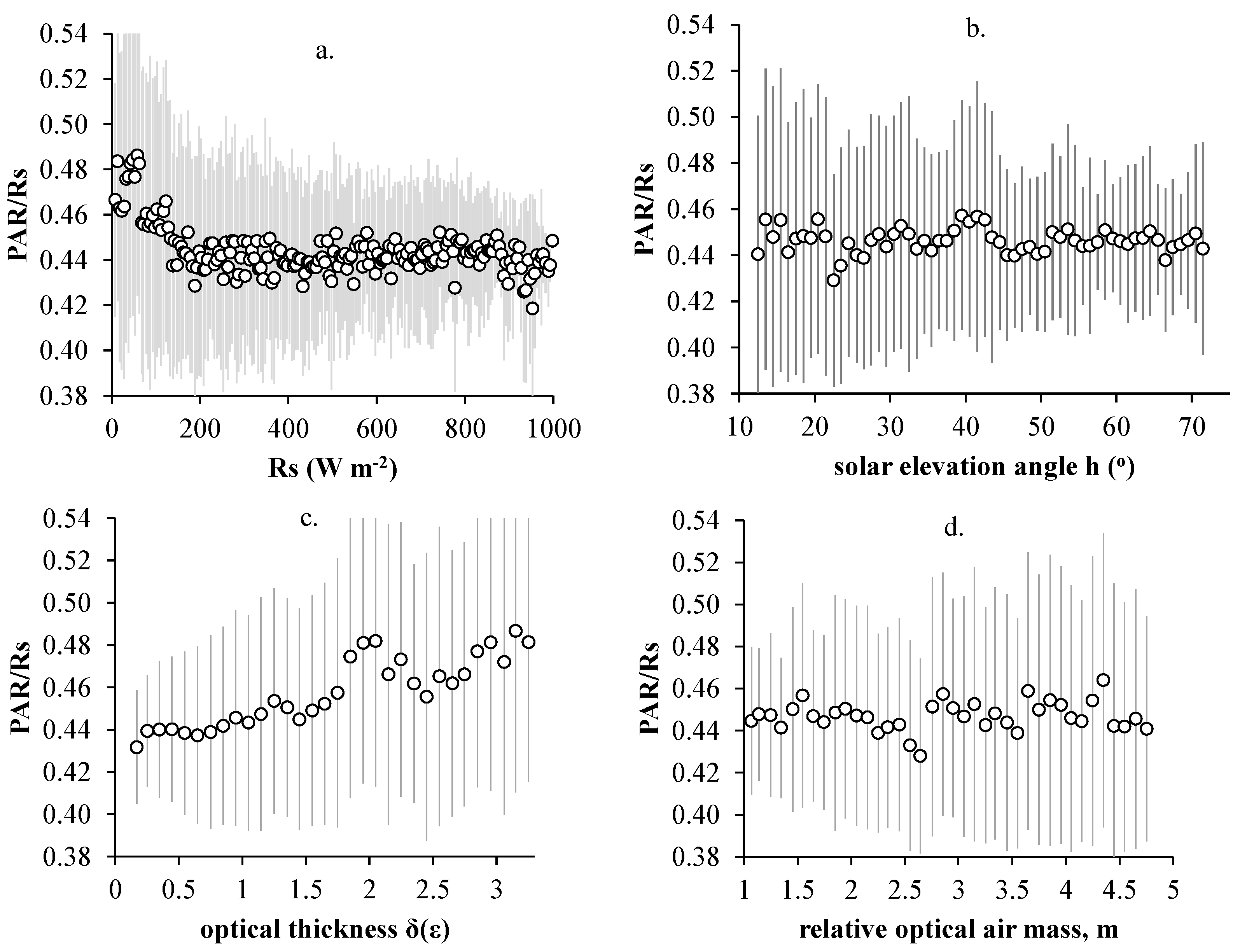
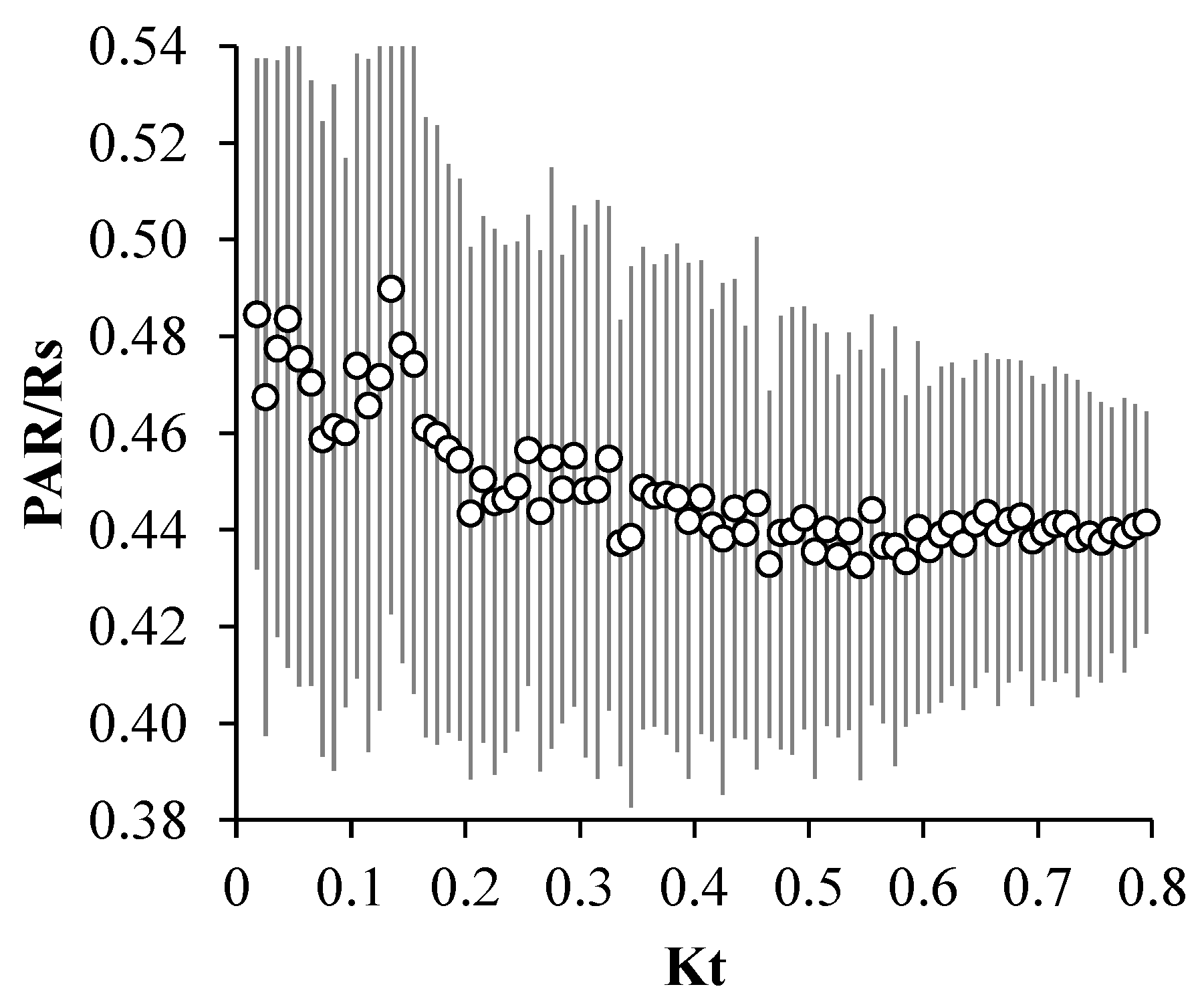
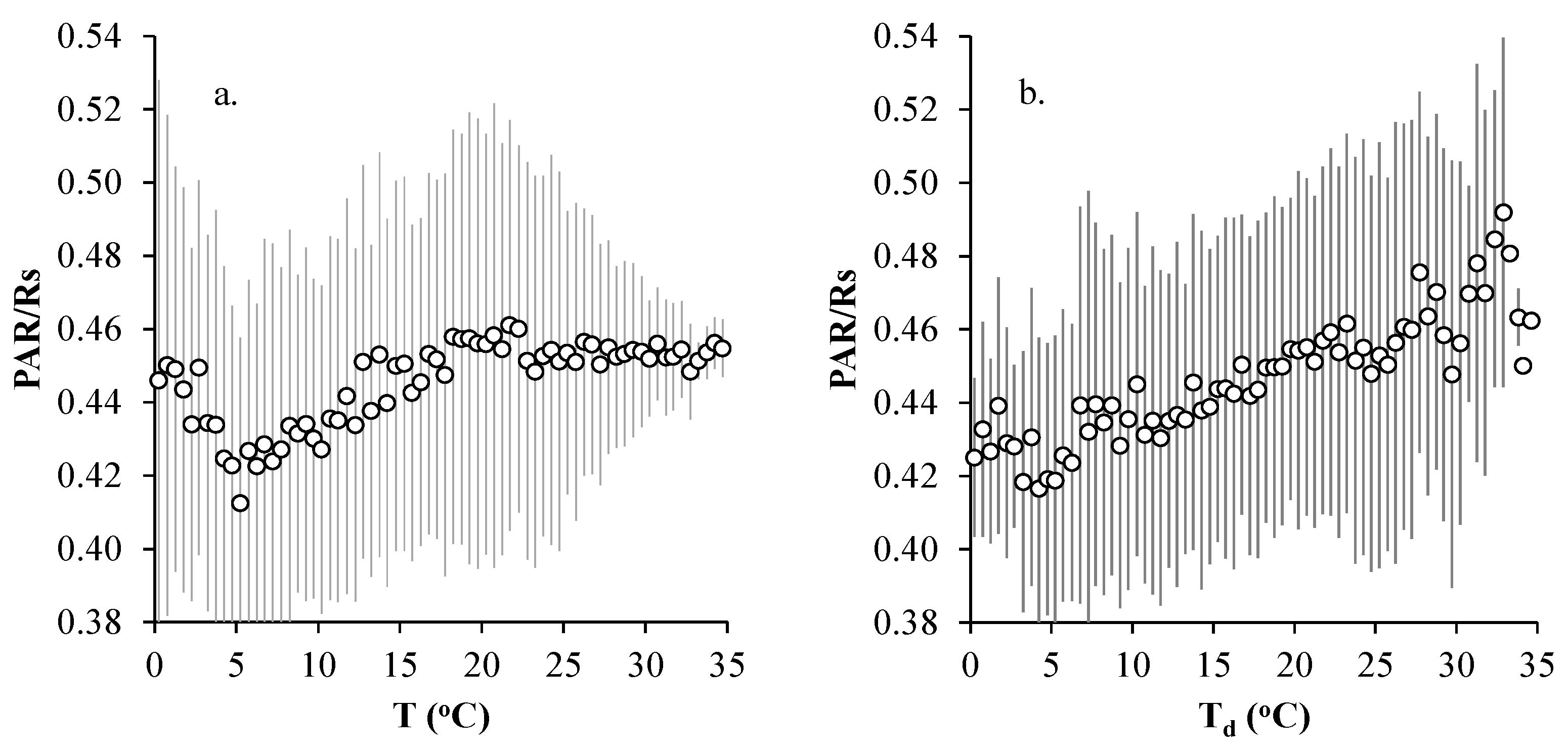
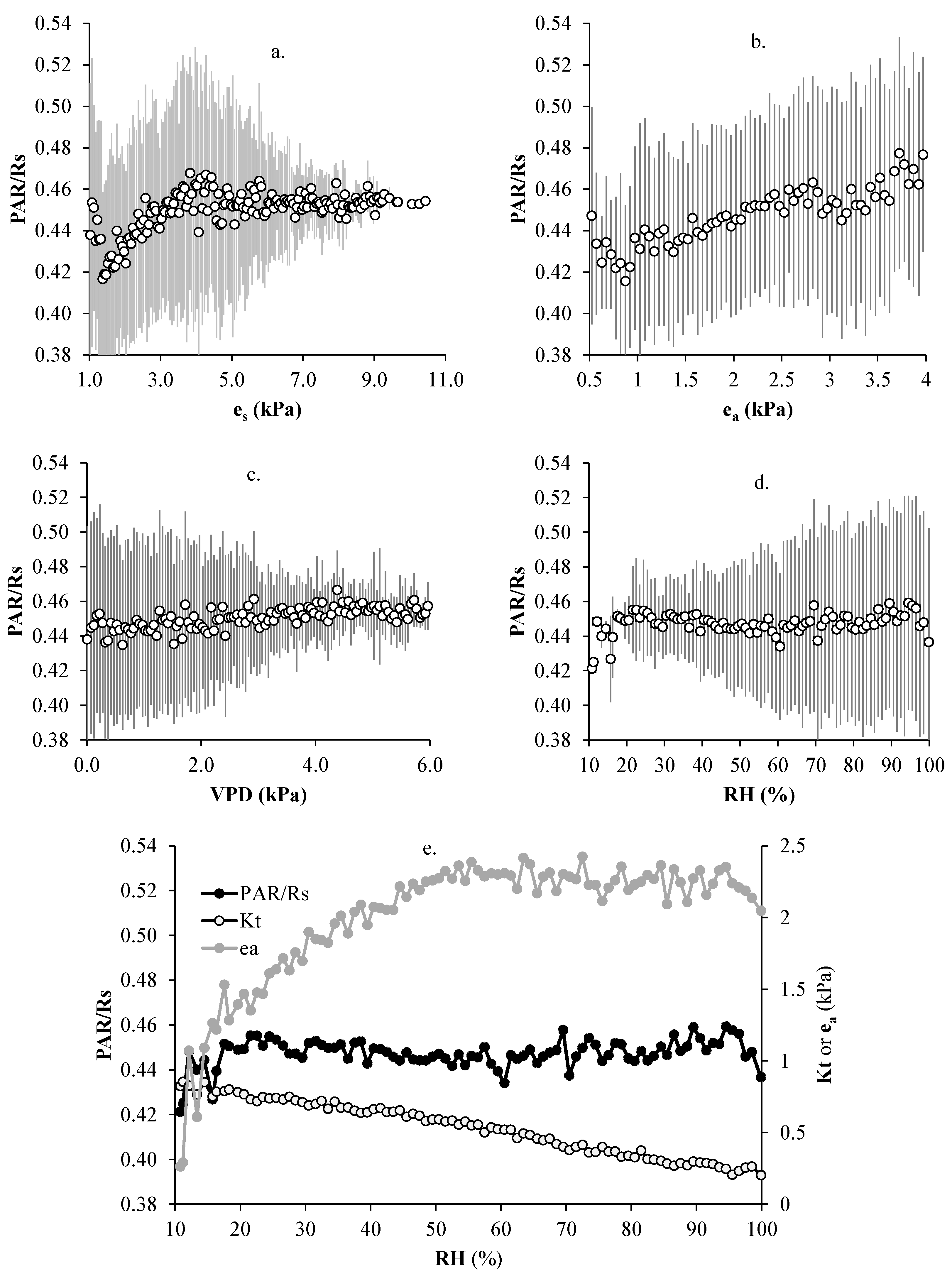
| Parameter | Description | Units | Mean | Maximum | Minimum | SD | CV (%) |
|---|---|---|---|---|---|---|---|
| Rs | Global solar radiation | W m−2 | 396.5 | 1166.4 | 5.1 | 269.1 | 67.9 |
| PAR | Photosynthetically Active Radiation | W m−2 | 175.3 | 489.1 | 2.1 | 119.4 | 68.1 |
| Kt | Clearness Index | unitless | 0.48 | 1.00 | 0.01 | 0.25 | 52.0 |
| T | Air Temperature | °C | 18.2 | 37.3 | 0.0 | 8.3 | 45.7 |
| Td | Dewpoint Temperature | °C | 17.7 | 34.7 | −11.4 | 6.6 | 37.4 |
| RH | Relative Humidity | % | 63.6 | 100.0 | 10.8 | 21.7 | 34.2 |
| ea | Actual vapor pressure | kPa | 2.17 | 5.52 | 0.26 | 0.82 | 37.9 |
| es | Saturation vapor pressure | kPa | 3.82 | 10.44 | 1.00 | 1.87 | 48.8 |
| VPD | Vapor pressure deficit | kPa | 1.65 | 8.67 | 0.00 | 1.49 | 90.0 |
| δ(ε) | Optical thickness | unitless | 0.95 | 4.21 | 0.00 | 0.76 | 79.1 |
| m | Relative optical airmass | unitless | 2.01 | 4.80 | 1.05 | 0.86 | 42.8 |
| Time Period | Σ(PAR/Rs)/N All Skies | Linear Correlations | Σ(PAR/Rs)/N | ||||||||||||||
|---|---|---|---|---|---|---|---|---|---|---|---|---|---|---|---|---|---|
| PAR = a Rs + b (y = ax + b) | PAR = a Rs (y = ax) | Overcast Skies (Kt < 0.3) | Intermediate Skies (0.3 ≤ Kt ≤ 0.7) | Clear Skies (Kt > 0.7) | |||||||||||||
| Average | SD | N | a | b | R2 | a | R2 | Average | SD | N | Average | SD | N | Average | SD | N | |
| Month | |||||||||||||||||
| January | 0.449 | 0.044 | 538 | 0.429 | 2.0 | 0.981 | 0.436 | 0.981 | 0.466 | 0.046 | 277 | 0.430 | 0.038 | 184 | 0.437 | 0.026 | 77 |
| February | 0.452 | 0.045 | 495 | 0.429 | 3.4 | 0.977 | 0.437 | 0.979 | 0.474 | 0.044 | 191 | 0.446 | 0.044 | 181 | 0.428 | 0.031 | 123 |
| March | 0.438 | 0.049 | 715 | 0.424 | 2.2 | 0.987 | 0.428 | 0.988 | 0.451 | 0.061 | 269 | 0.431 | 0.045 | 278 | 0.426 | 0.024 | 168 |
| April | 0.440 | 0.042 | 906 | 0.426 | 4.4 | 0.976 | 0.433 | 0.98 | 0.448 | 0.051 | 256 | 0.442 | 0.040 | 440 | 0.427 | 0.031 | 210 |
| May | 0.446 | 0.039 | 797 | 0.428 | 5.4 | 0.981 | 0.436 | 0.985 | 0.467 | 0.056 | 182 | 0.443 | 0.031 | 388 | 0.433 | 0.025 | 227 |
| June | 0.459 | 0.055 | 695 | 0.435 | 7.1 | 0.956 | 0.446 | 0.965 | 0.485 | 0.058 | 189 | 0.457 | 0.056 | 319 | 0.437 | 0.037 | 187 |
| July | 0.464 | 0.048 | 1451 | 0.436 | 7.7 | 0.984 | 0.448 | 0.979 | 0.500 | 0.063 | 367 | 0.458 | 0.039 | 614 | 0.445 | 0.021 | 470 |
| August | 0.462 | 0.039 | 1685 | 0.443 | 4.0 | 0.991 | 0.449 | 0.988 | 0.506 | 0.055 | 349 | 0.452 | 0.026 | 758 | 0.448 | 0.017 | 578 |
| September | 0.440 | 0.051 | 1094 | 0.443 | −2.0 | 0.971 | 0.439 | 0.972 | 0.446 | 0.068 | 272 | 0.434 | 0.047 | 551 | 0.444 | 0.032 | 271 |
| October | 0.433 | 0.058 | 719 | 0.424 | 0.7 | 0.965 | 0.425 | 0.966 | 0.449 | 0.069 | 280 | 0.420 | 0.046 | 331 | 0.431 | 0.048 | 108 |
| November | 0.419 | 0.042 | 752 | 0.429 | -1.7 | 0.972 | 0.424 | 0.973 | 0.416 | 0.043 | 357 | 0.420 | 0.042 | 299 | 0.423 | 0.040 | 96 |
| December | 0.425 | 0.041 | 675 | 0.415 | 1.4 | 0.975 | 0.420 | 0.978 | 0.434 | 0.046 | 245 | 0.423 | 0.040 | 292 | 0.413 | 0.028 | 138 |
| Season | |||||||||||||||||
| Winter | 0.441 | 0.045 | 1708 | 0.426 | 1.6 | 0.977 | 0.431 | 0.978 | 0.457 | 0.048 | 713 | 0.431 | 0.041 | 657 | 0.424 | 0.030 | 338 |
| Spring | 0.441 | 0.044 | 2418 | 0.427 | 3.5 | 0.981 | 0.433 | 0.984 | 0.454 | 0.057 | 707 | 0.440 | 0.039 | 1106 | 0.429 | 0.027 | 605 |
| Summer | 0.462 | 0.046 | 3831 | 0.439 | 6.0 | 0.981 | 0.448 | 0.978 | 0.499 | 0.060 | 905 | 0.455 | 0.038 | 1691 | 0.445 | 0.023 | 1235 |
| Autumn | 0.432 | 0.051 | 2565 | 0.439 | −2.4 | 0.974 | 0.434 | 0.973 | 0.436 | 0.062 | 909 | 0.427 | 0.046 | 1181 | 0.437 | 0.039 | 475 |
| Annual | 0.446 | 0.048 | 10,522 | 0.435 | 0.2 | 0.982 | 0.436 | 0.980 | 0.462 | 0.062 | 3234 | 0.441 | 0.043 | 4635 | 0.437 | 0.029 | 2653 |
Publisher’s Note: MDPI stays neutral with regard to jurisdictional claims in published maps and institutional affiliations. |
© 2022 by the authors. Licensee MDPI, Basel, Switzerland. This article is an open access article distributed under the terms and conditions of the Creative Commons Attribution (CC BY) license (https://creativecommons.org/licenses/by/4.0/).
Share and Cite
Proutsos, N.D.; Liakatas, A.; Alexandris, S.G.; Tsiros, I.X.; Tigkas, D.; Halivopoulos, G. Atmospheric Factors Affecting Global Solar and Photosynthetically Active Radiation Relationship in a Mediterranean Forest Site. Atmosphere 2022, 13, 1207. https://doi.org/10.3390/atmos13081207
Proutsos ND, Liakatas A, Alexandris SG, Tsiros IX, Tigkas D, Halivopoulos G. Atmospheric Factors Affecting Global Solar and Photosynthetically Active Radiation Relationship in a Mediterranean Forest Site. Atmosphere. 2022; 13(8):1207. https://doi.org/10.3390/atmos13081207
Chicago/Turabian StyleProutsos, Nikolaos D., Aristotle Liakatas, Stavros G. Alexandris, Ioannis X. Tsiros, Dimitris Tigkas, and George Halivopoulos. 2022. "Atmospheric Factors Affecting Global Solar and Photosynthetically Active Radiation Relationship in a Mediterranean Forest Site" Atmosphere 13, no. 8: 1207. https://doi.org/10.3390/atmos13081207






